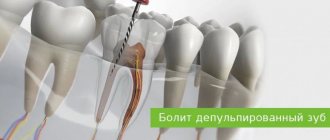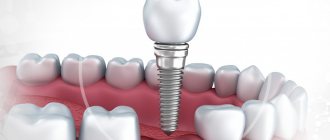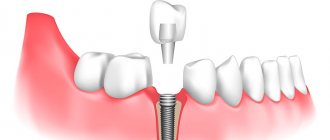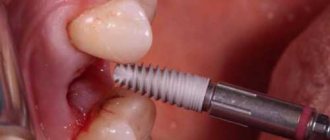Indications for tooth extraction include dental diseases that cannot be treated conservatively or surgically. Sometimes the dentist is unable to save a tooth from irreversible pulpitis caused by root canal obstruction or insufficient tooth tissue needed for reconstruction, in situations where the patient presents to the clinic too late. Indications for removal also include: weakening of tooth roots, recurrent inflammation of the periapical region. Often a tooth is removed for orthodontic reasons. During the diagnostic process, the orthodontist may come to the conclusion that there is not enough space for large teeth in a small jaw. A tooth can also break or crack as a result of trauma to the facial part of the skull. However, not all damaged teeth are doomed to be removed.
Separately, it is worth highlighting tooth extraction as part of a one-stage implantation plan. That is, when a tooth is removed and an implant is immediately installed in the newly formed hole. This procedure can be carried out provided that:
- The alveolar process is of sufficient size and does not require the addition of artificial bone replacement material.
- There is no need to perform a sinus lift. Some doctors delay implantation for 4-6 months after this procedure, others decide to implant immediately after raising the floor of the maxillary sinus. Evaluation of the choice of method is the responsibility of the implantologist and largely depends on the individual clinical picture.
- There are no systemic contraindications.
Why implantation?
All methods of dental prosthetics prior to implantation negatively affect the condition of the oral cavity in the future, often causing premature wear and loss of teeth. In particular, the manufacture of bridge-like prostheses - bridges, as they are also called - requires the depulpation and preparation of two, and sometimes three, teeth to replace just one lost tooth.
Such radical treatment, to put it mildly, is not beneficial for the jaw system and leads to overload of the supporting units with further root inflammation and tooth loss. At the same time, the average service life of “bridges” is 6-7 years.
The situation with removable dentures is even more complicated: for any removable device, the support is the gums and bone tissue of the jaw, which, in principle, is not adapted to a full chewing load. As a result, a chronic inflammatory process develops, and the bone atrophies and dissolves.
Complications following dental implantation
The use of modern implantation methods and high-quality dental products has made it possible to increase the popularity of this method over the previous twenty years. On average, the survival rate of dental elements over a period of 7-10 years is currently at almost one hundred percent success level. Moreover, success rates in the lower jaw are higher than in the upper jaw. This depends on the fact that the lower jaw bone is the densest.
To conclude, rejection of dental elements is not common, and the main reason for patient dissatisfaction is the deterioration of the aesthetic appearance where the gums are adjacent to the dental element. At the initial stage, it may look like a not very noticeable cyanosis of the gums, which will increase over time. Over time, gum recession may occur, that is, the neck of the dental element may be exposed.
This all occurs due to bone resorption near the neck of the dental element, as a result of which the metal part of it, which is deprived of bone tissue, begins to be visible through the gums, which gives a bluish appearance. The subsequent decrease in bone level results in loss of bone support and a reduction in bone level following the bone. Gum recession appears.
Based on practice, the occurrence of bone resorption and recession is only caused by errors and shortcomings of the treating dentist. The most common mistakes are:
- There is a thin bone wall (less than two millimeters) on the side of the front surface of the dental element, and the dentist, observing this, did not replant the bone, which leads to resorption of the upper part of this bone wall.
- Thin gum (two millimeters or less) on the jaw crest of the alveolar process, which does not allow the formation of the required volume of soft tissue near the dental element, and the dentist, observing this, did not increase the thickness of the gum. This could be done by transplanting a small flap of mucous membrane from the palate.
- Small distances (less than three millimeters) that separate the lateral surfaces of the dental element from the adjacent teeth or other dental elements, which leads to resorption of the lateral bone septa and a decrease in the level of interdental papillae.
In addition, there are other reasons, so you need to contact a competent specialist.
What to prepare for
Dental implantation is a technique that does not have the disadvantages of previous generations of prostheses. Implantologists consider it as the only way to restore lost teeth that does not harm the health of the oral cavity and has an unlimited (usually lifelong) service life.
Important! No other prosthetic method provides such high aesthetics as implantation.
But it should be taken into account that dental implantation is not a simple procedure during which an implant is simply inserted in place of the missing unit. The future tooth (more precisely, its root) must have a certain size, the proper position and direction, and a strictly defined inclination are selected for it.
In addition, it is necessary to restore all the tissue surrounding the tooth - and, first of all, bone tissue and gums. It is this comprehensive approach that allows us to achieve reliability, impeccable aesthetics, and durability of implant treatment.
Implantation is a slow process, except for one-stage implantation, as well as the “all on 4” and “all on 6” techniques. Treatment usually involves several stages, despite the common name of "two-stage" surgery.
Treatment always begins with diagnosis, which is the first and, perhaps, the most important stage that determines its outcome. Based on the results of the preliminary examination, a decision is made on implantation technology, types of implants, and the details of the upcoming operation are thought out.
Important! It is necessary to prepare for the fact that during the implantation process you will have to go through several stages. A standard scheme applies to all patients, so we have prepared a detailed description of each stage of dental implantation.
Implantation with laser
This method of implantation is the most advanced and technologically advanced. The operation is carried out practically, like the classic procedure, but instead of a scalpel, a laser is used to cut the gums. The percentage of engraftment is the highest and reaches almost 100 percent. Laser technology is used in the following situations:
- If the gum is cut and the dental implant is not installed immediately after healing.
- If the mucous membrane is re-opened, that is, with two-stage implantation.
- When the gum restoration process is carried out.
Implantation using a laser is carried out in several stages:
- First, preparation is carried out, during which the weight of the future tooth is calculated. This is necessary in order to understand what kind of load the gums will experience. If the dentist believes that there may not be enough bone tissue to perform the operation, then a sinus lift is performed (bone tissue is built up).
- Then the implant is inserted. But before this, a small incision is made using a laser; it is into this that the dental element will be inserted. It is implemented using high-tech and sensitive equipment - a physical dispensary. After implantation, sutures are placed on the laser-cut gum. Then a temporary crown is installed.
- Next comes the recovery process. Depending on the characteristics of the human body, this process can take from two to six months. During this time, the dental element must grow together and become accustomed to the bone tissue.
- After the implant has completely taken root, the second stage of laser implantation is carried out. Using a laser beam, the gums in the healed area are opened and a permanent crown is installed. It can be made of metal ceramics, metal-free ceramics, zirconium and titanium.
The main positive aspects of using this method are the following:
- Bleeding during the procedure is almost completely absent, since the gums are cut not with a scalpel, but with a laser beam. The laser beam instantly burns through the blood vessels. Due to the fact that there is no bleeding, there is no likelihood of inflammatory processes.
- The incision is made with a minimum length, on average it is made one centimeter long for each extracted tooth. The bone tissue is evaporated, so there is virtually no damage. The procedure is considered virtually non-traumatic, since this indicator is minimal. The tissues are restored and healed quite quickly. After installing a permanent prosthesis, you can return to your normal lifestyle and eat all foods.
- This operation using a laser takes a minimal amount of time. Within half an hour, the dentist makes an incision in the gum, implants a dental element and sutures the cut gum tissue.
- The procedure is completely sterile, since the laser beam has bactericidal properties.
- Side effects are practically absent completely. When using a scalpel, the dentist cannot guarantee that there will be no ingress of metallic dust. Metal particles can react with the surface of the implant, become electrified, and thus the patient will experience uncomfortable sensations. With the laser cutting method, this possibility is impossible.
- Anesthesia is used in minimal doses. Due to the minimal risk of injury and pain, a minimal amount of anesthetic is used to numb the incision site. In addition, it reduces the burden of drugs on the human body.
- Lack of psychological discomfort. From a psychological point of view, this operation is much easier, since it is not associated with bleeding gums. From the patient's point of view, cutting with a laser beam is less traumatic.
- The period of use of the implant is almost lifelong. The dental element is attached to the jaw very firmly, practically like a healthy tooth, therefore the period of use of the implant is very long.
The indications for the use of this laser method are practically no different from the indications for traditional implantation with a scalpel. An implant can be implanted using this method in any age category.
Stage 1: diagnosis
It may take some time to choose a clinic and an implantologist, since this is one of the key points in the whole story. In addition, you need to get to know the orthopedist and, if necessary, the therapist - these doctors will also take part in the process of implantological treatment. If everything is satisfactory, then before implantation an examination is carried out by a surgeon.
He will tell you whether it is possible in principle to place an implant in this patient, and will develop further treatment tactics based on the following data:
- general oral health;
- the presence and condition of neighboring teeth and gums, which are located next to the future implant root;
- bite;
- hygiene quality;
- financial capabilities of the patient.
The price is usually included in the total cost of treatment, which is carried out in most clinics on a turnkey basis. The doctor will announce the approximate cost, the final price is determined after diagnostic testing and consultation with an orthopedist. If a patient needs the help of a physician, hygienist or periodontist, then their services should be considered.
Diagnostics includes instrumental and laboratory studies, without which surgery is impossible. These examinations are necessary to exclude a number of complications after the introduction of implant rods and achieve extremely good treatment results.
Instrumental studies – tomography and x-ray
They are performed on all patients, regardless of the chosen implantation technology. Based on the data obtained, the issue of the types of implants and the methodology of the implantation operation itself will be decided.
An X-ray is taken selectively, precisely in the part of the jaw where implants are planned to be installed. Using it, the doctor evaluates the condition and location of the roots of the teeth, near which the implant should be installed. The price of such a photo starts from 700 rubles.
A panoramic photograph is needed for any type of prosthetics, and implantation is no exception. Otherwise, it is called an orthopantogram and is performed to take into account the characteristics of the bite and the condition of the bone tissue. All this is of great importance, since a strong foundation is extremely important for the implant root.
The price of a 3D image - orthopantogram - from 1500 rubles.
But the most important study at the diagnostic stage is CT - computed tomography. Without it, not a single dental implantation operation is performed, and neither an X-ray nor an orthopantogram can replace it.
Computed tomography is the most expensive examination at the diagnostic stage, the price of which starts from 3,000 rubles. Based on its results, the quality of bone tissue is assessed, the sites for installing implants and their type are selected. It is the tomogram that allows the implantologist to conclude that bone grafting is necessary if there is insufficient bone volume.
Modern medical centers where implantation operations are performed are equipped with high-precision equipment and use navigation programs. All this makes it possible to plan the course of treatment in detail and even show its future results to the patient!
Lab tests
The diagnostic stage before implantation necessarily includes a general and detailed blood test. This is a must for everyone. Certain categories of patients will need to provide the results of hormone tests (usually women) and other specific laboratory tests if there are concomitant pathologies.
A number of diseases are a relative contraindication for surgery to install implants, and then a preliminary consultation with a specialist is necessary. If necessary, before implantation, the condition is corrected to acceptable levels (for example, in the case of diabetes).
The price of sample collection services may vary and depends not only on the number of studies. Many tests are done in district clinics, and will be free if referred by a doctor. Thanks to this approach, diagnostic costs can be significantly reduced.
At the diagnostic stage, all patient data is collected, and based on the information obtained, the optimal method of dental implantation and type of implants are selected. After agreeing on the finished plan with the client, we begin to implement it. Next begins the stage of preparation for the implantation operation.
In what cases is it necessary to donate blood for testing?
For healthy patients, it is enough to take an X-ray of the jaw before implantation. If the patient mentioned in the questionnaire about allergies, chronic diseases and other possible obstacles to surgery, additional research will be required. They are recommended for the following conditions:
- Allergy . If a patient has an allergic reaction to drugs, allergy tests are prescribed. This is necessary for choosing anesthesia.
- Taking medications to reduce blood clotting . A consultation with the attending physician is required to cancel anticoagulants for 2-3 days during the implantation period. Due to poor clotting, bleeding may begin and complications may arise.
- Diabetes. High blood sugar levels (from 12-15 mmol/l) are a contraindication to surgery. The doctor will recommend reducing your glucose level to at least 8-10 mmol/l. This will reduce the risk of implant rejection.
- Taking bisphosphonates (drugs to treat osteoporosis and some cancers). They worsen the healing process and often cause rejection of titanium roots.
Patients with cardiovascular diseases require permission for surgery from a general practitioner and cardiologist. For example, hypertension causes bleeding during implantation. There are other pathologies that require the supervision of highly specialized physicians.
Stage 2: preparatory
Details of the preparatory stage may vary significantly for different patients due to differences in the condition of the oral cavity in general and the jaw bone tissue in particular. Most people planning to have implants require dental hygiene.
Sanitation is carried out with the aim of eliminating bacterial plaque from the surface of tooth enamel, since a successful implantation operation requires, if not sterility, then maximum cleanliness of the oral cavity. The presence of pathogenic microflora can provoke the development of inflammation, which should be avoided at any stage of implantation.
Hygienic cleaning is done using ultrasound when there is existing tartar, soft plaque is removed using Air Flow technology. The price of such reorganization is from 6,000 rubles.
At the preparatory stage before implantation, it may also be necessary to remove teeth, treat caries and periodontitis. The price of each procedure is calculated separately.
But the most serious step before installing implants may be bone grafting surgery. Very often it is impossible to do without it due to a lack of bone due to its resorption - resorption, natural loss. Bone volume can be greatly reduced if a tooth is lost or removed long ago, or due to individual characteristics.
As a rule, bone grafting is performed in the case of classical two-stage implantation, which places high demands on the quality of the jaw bone tissue. In addition, bone grafting is almost always necessary for patients who have lost teeth a year or more ago. During this period, the bone undergoes rarefaction and becomes brittle, which creates certain difficulties with fixation of implant roots.
There are several methods for performing bone grafting, or osteoplasty, using different materials. Therefore, the price will depend on the selected operation technology. There are 3 options in total:
- sinus lift;
- directed regeneration;
- autotransplantation.
What tests are needed for implantation under sedation?
Modern dentistry offers implantation using anesthesia or sedation, which are used for various types of operations.
Sedation is the introduction of a patient into medicated sleep with ultra-short-acting medications using an infusion pump. After turning off the device, the patient wakes up as if after a nap. In 10 minutes he can go home, in half an hour he can get behind the wheel. You should not have blood tests before sedation.
For anesthesia, narcotic drugs are used, and a tube is inserted into the trachea to ensure airway patency. This type of pain relief is difficult to tolerate by the body and requires preliminary preparation in the form of a blood test. After the operation, the patient remains in the hospital for another 2 days. Our Center does not use anesthesia.
Preparation for implantation in a dream includes:
- drawing up a treatment plan by the dentist, determining the scope of procedures;
- consultation with an anesthesiologist to determine the drug and its dosage.
The anesthesiologist gives detailed recommendations on preparing for implantation at home:
- stop eating and drinking 6 hours before surgery;
- do not drink alcohol for 2-3 days;
- a day abstain from tea, coffee;
- adjust with your doctor or anesthesiologist the intake of medications for the treatment of diseases (if necessary).
If you are offered anesthesia at any clinic, be prepared for the following mandatory additional measures:
- consultations with specialized doctors;
- electrocardiography;
- General and biochemical analysis of blood, urine, coagulogram.
Sinus lift
Sinus lift or subantral augmentation surgery before implantation can only be performed on the upper jaw. Its essence is to raise the lower septum of the maxillary sinus in order to increase the space of the alveolar ridge. The space thus freed is filled with bone tissue.
On a note! Sinus lifting is scientifically called subantral augmentation.
If there are no contraindications, the implantologist can combine sinus lifting with the installation of implants. Otherwise, the latter are placed in the jaw bone 3-6 months after the subantral augmentation surgery.
Sinus lifting can be open or closed, and its price depends on the chosen method. Open operations are estimated at the amount of 40,000 rubles, closed ones - from 20,000 rubles. It is important to know that this cost does not include the price of the bone material itself.
How much does it cost to remove a dental implant?
Removing the implant from the jaw itself is inexpensive. As a rule, the price is close to a complex tooth extraction, which on average is estimated at 5,000 - 15,000 rubles. However, the cost of removing a dental implant consists of many factors, so the total amount can sometimes exceed the cost of the implantation itself. Often, after completion of the extraction operation, osteoplastic surgery, soft tissue plastic surgery, and in some cases, manipulations from the field of maxillofacial surgery are necessary. That is why it is not possible to name the exact price for removing a dental implant - it all depends on the degree of complication and the specific clinical case.
Autotransplantation (autologous transplantation)
Another type of bone grafting performed before implantation. It is essentially a self-transplant since the recipient is his own donor. A similar technique is used for extensive burns, when areas of the patient’s healthy skin are transferred to the burned areas.
A similar technology is widely used by implantologists. During surgery, bone blocks taken from the patient are implanted into the jaw bone. The recovery period after installing implants using autologous transplantation is quite long and can last up to six months.
Implantation of implant roots is possible after completion of osseointegration, after 6 months. The asking price is at least 50,000 rubles.
Stage 3: installation of implants
If bone grafting was performed, then the stage of dental implantation itself proceeds six months after the healing of the jaw tissue and successful integration of the bone. Surgical treatment for implantation of implant roots, in turn, is also divided into several stages, including:
- Stage 1 – pain relief. The type of anesthesia is planned at the diagnostic stage, and its choice depends on the scope of the intervention. When installing 1-2 titanium rods into the jaw, local anesthesia is usually given. If there are more, implantation may require general anesthesia or sedation;
- Stage 2 – incision of the gums and periosteum to gain access to the surgical field;
- Stage 3 – drilling a hole for the implant root in exact accordance with its dimensions and forming notches on the walls of the hole for better fixation of the future tooth in the jaw. The prepared hole is treated with an antiseptic, dried, after which the implantologist begins to screw in the implant itself;
- Stage 4 – installation of a plug to prevent tissue from growing inside the implant root;
- Stage 5 – suturing the gums and suturing. Implantation is complete.
On a note! Implant sedation is often chosen by patients who experience panic attacks before dental treatment. It is also indicated for people with heart disease and hypertension. Sedation is a safer alternative to general anesthesia, which is advisable to use for multiple dental implantations and bone grafting.
After the implants are installed, the patient is under the supervision of a doctor for some time, who at the same time instructs him regarding further treatment and care. If there are no signs of complications, after a couple of hours the person goes home, where he takes medications to speed up the healing of the gums and stimulate the osseointegration of the implant roots. In addition, he is given a leaflet with recommendations regarding oral hygiene after implantation.
The sutures after implantation are usually removed after a week, then a temporary crown can be installed. The price of the main stage largely depends on the type of implants.
General overview
Inside the dental canal there are capillaries, lymph vessels, nerve and connective fibers, which in their natural state are responsible for saturating dentin and enamel with essential minerals. Failure to comply with the dental treatment protocol, prolonged development of pathologies, as well as mechanical injuries and damage associated with destruction of the structure cause disruption of biological processes. The devitalization procedure involves killing the nerves that cause pain - arsenic is used for this, as well as other compounds placed in the cavity of the crown. Achieving the desired result allows you to move on to depulpation - expansion of the canal and removal of the affected pulp, eliminating the likelihood of recurrence of the abnormal condition.
Stage 4: rehabilitation after implant installation
The rehabilitation period is the time during which the implant root takes root in the patient’s own tissues. Only after osseointegration is completed can one proceed to the orthopedic stage and place permanent crowns.
It is impossible to shorten the healing time of implant roots, even if you take special calcium supplements and other medications. Depending on individual characteristics, it can average 3-6 months, although in most cases it takes at least six months.
The implantologist may recommend regular visits to the clinic to monitor the survival of the implant root (or roots). However, in the absence of discomfort and complications at the rehabilitation stage, the patient makes the next visit to the clinic at the very end. Next, a date is set for placing a gum former on the implant.
How is the socket prepared for implantation?
The entire procedure takes place under anesthesia, so the patient will not feel pain or discomfort. It is important for the patient to choose effective anesthetic drugs that do not cause allergies and eliminate all pain. Therefore, when creating a treatment plan, pay more attention to preparation and diagnosis. During the procedure, the implantologist will perform the following actions:
- Treat the surgical site with an antiseptic.
- Fill the hole with a bone-forming compound.
- Cover with a special hypoallergenic membrane.
- Fixes the surgical surface by tensioning the free edges of the connective tissue.
- He will put stitches.
Stage 5: insertion of the healing abutment
This detail is necessary to give natural contours to the gums in the operated area. The former is screwed directly into the implant rod by cutting the soft tissue.
In essence, the plug is replaced, which is unscrewed, and a former is placed in its place in the implant channel. The manipulation is very simple and quite fast. An experienced implantologist performs it in a matter of minutes, maximum in half an hour, regardless of the type of implant. But an anesthetic injection is still given due to the incision of the mucous membrane.
This is where the main and most serious part of dental implantation ends, and after a week or two they move on to screwing in the abutment.
Step 6: Abutment Installation
The abutment is screwed directly into the implant root; it is the abutment that is the connecting link between the implant and the crown/prosthesis. The abutment is installed 2 weeks after the former and is selected individually for each client.
For example, when implanting teeth in the smile area and thin gum tissue, it is recommended to install zirconium abutments, since titanium “spare parts” can negatively affect aesthetics.
Placement of the abutment completes the implantation procedure and treatment continues with the prosthodontist.
Nutrition.
- Avoid drinking alcoholic beverages several days before implantation, at least 1-2 days. Alcohol reduces blood clotting and reduces the analgesic effect of anesthetics.
- Limit or completely eliminate coffee consumption for a couple of days, as this can negatively affect blood pressure.
- The diet should be varied, including a complex of vitamins and minerals. The diet should include vegetables, herbs, fruits, meat, chicken, fish, eggs, milk, cheese.
Stage 7: prosthetics
After 1-2 weeks from the installation of the abutment, impressions of the teeth and jaws can be made. Crowns can be made from absolutely any material, but ceramic products are more suitable for front teeth. Implant roots in the area of chewing teeth are complemented by metal-ceramic or zirconium crowns.
The price of prosthetics varies depending on its type, since both crowns and removable, as well as conditionally removable dentures are placed on implants. In addition, the cost is affected by the material they are made of.
On a note! Zirconium is the most expensive, but also the most reliable material, which has high strength and excellent aesthetic qualities.
Life after implantation
Once the implants have settled in and the crowns have been placed, it is important to properly care for them in order to maintain the results for as long as possible. The rules for caring for teeth with implant roots are standard, but with some peculiarities.
Firstly, you should use a brush with medium-hard bristles to avoid traumatizing the mucous membranes and ensure high-quality cleansing of new teeth. An implantologist or orthopedist will advise which paste is best to choose.
Secondly, it is advisable to rinse your mouth after every meal, but alcohol-based rinses are not suitable for this due to their ability to dry out the mucous membranes. A person with installed implants should have dental floss and an irrigator in their arsenal.
On a note! Insufficiently careful care of teeth on implants can shorten their service life and even lead to rejection.
One-stage, instantaneous implantation
Dental implantation of teeth can be not only two-stage, but also one-stage, one-step. If you choose one of these procedures, the installation of implants will take much less time, at least due to the absence of the need to build up bone before implantation.
In one stage, implantation is performed in two cases: with satisfactory bone condition and the use of special types of implants. During surgery, the implant is installed, and a temporary crown is immediately placed.
Unlike one-stage implantation, one-stage implantation involves the simultaneous removal of a tooth and the introduction of an implant into the same hole. But, like one-stage, one-stage implantation is performed with immediate loading, that is, after installing the implant, an abutment is immediately screwed onto it and a temporary prosthesis is placed.
Important! A temporary prosthesis on an implant can be replaced with a permanent structure after six months.
Classic one-stage implantation is also called non-surgical express implantation. It has a number of advantages, since the client:
- saves time - implants are installed in one visit to the doctor;
- saves money - the final cost of one-stage implantation is lower than classical two-stage implantation;
- obtains excellent aesthetics even in the absence of most teeth - and in the case of complete edentia, a dazzling smile can be achieved within 3 days;
- recovers quickly after installation of implants, and with a lower risk of infection, swelling and other complications, since simultaneous implantation is performed without an incision or stitches.
Thus, implantation in one visit to the dentist is the best solution, since it allows you to do without bone augmentation, which means saving time, money and preserving your own bone tissue in the area of the implant root.
Indications and contraindications
Indications for the procedure:
- To prevent bone loss. — To eliminate defects associated with periodontal disease. — Creation of an optimal contour of bone and soft tissue to preserve the anatomical features of this area. — To ensure a good aesthetic result.
There are contraindications:
— Acute infectious diseases of the nasopharynx and oral cavity. — Oncological diseases. — Pregnancy and breastfeeding. — In immunodeficiency states. — State of acute pain after removal.











